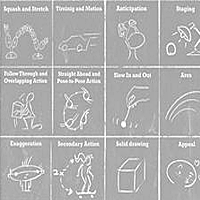
welcome
Anyone pursuing an animation degree in Delhi or anywhere else in the world should be aware of the principles of animation. They are the principles upon which all works of animation are built. These principles go a long way in making an animation work appear realistic or fake, smooth or jerky, fluid or erratic. Every student taking an animation degree must take note of all these principles in the world of animation and film.
- ARCS
The movement path of models (with the exception of mechanical Materials) tends to form an arc. Movement of limbs of organic characters and even some inorganic characters all follow an arched trajectory for greater realism. The shape of the resultant arc also correlates with the speed of that object in time.
- TIMING
Timing ensures that the animation of objects follows the correct laws of physics. There is a time-space for every natural action. If the correct timing is not adhered to, realism would be lost. For instance, a human walk cycle should be about 25 frames for 24 frames per seconds’ animation while running depending on the speed required would take fewer frames.
- STAGING
This principle focuses on how scenes should appear. Scenes should be staged, keeping in mind the most important aspects of the scene. Staging deals with camera placements, viewpoint angles and panning, all essential parts of an animation film.
- EASE IN AND EASE OUT
While pursuing an animation degree in Delhi or anywhere else in the world, the most recurring term would be “ease in and ease out”. This applies Newton’s Laws of motion into the animation of objects. It simply ensures that object gain, maintain than lose momentum at the beginning, middle and end of a specified action respectively. Just like the acceleration of a car moving from a standstill, it starts slows, gains momentum and then dies out when the car comes back to a standstill.
- ANTICIPATION
In animation, a little time is given for action anticipation. This is not very pronounced in real life acting but creates a huge effect in animation which helps with delivery and entertainment.
- EXAGGERATION
In animation, actions are a bit exaggerated than what is acceptable in real life human acting. This is also for the purpose of delivery and entertainment.
- SQUASH AND STRETCH
Squash and stretch in animation help to convey the illusion of weight and flexibility of objects. Depending on the degree of realism needed, objects can squash and stretch to varying degrees while still maintaining their volume in an animation work.
- STRAIGHT AHEAD AND POSE TO POSE
This principle details how an animation is carried out. Straight ahead animates an object according to subsequent frames and positions in the animation. Pose to pose, sets object position in two frames apart and then tweens them.
- FOLLOW THROUGH AND OVERLAPPING ACTION
In the quest for the realism of characters, the principle of follow-through is adopted. This principle taught in animation degree courses ensures that other parts of an organic character have corresponding movements from a major movement in the same character, these corresponding movements usually have a time delay from the major movement.
- SECONDARY ACTION
Very similar to follow through, this principle ensures that characters primary actions have some form of accompanying secondary action for the sake of realism. For example, a walking man can also swing his arms.
- SOLID DRAWING
This principle ensures that objects to be animated are modeled in three-dimensional space, taking into consideration, weight, height, and volume.
- APPEAL
This is the basis of all animation work, taught by an animation degree courses. All work done must have the appeal, the real and interesting factor to it.
Put all these principles to practice with an animation degree in Delhi with TGC Animation and Multimedia, New Delhi, India or call or for more detail call 1800 1020 418 Toll-Free No. for free counseling.





0 Responses on The Principles of Animation"